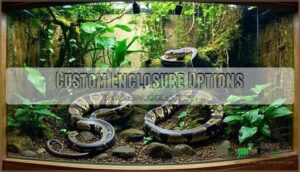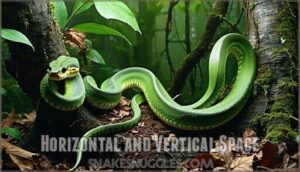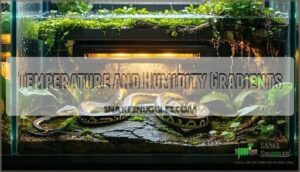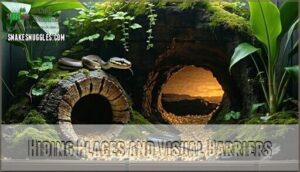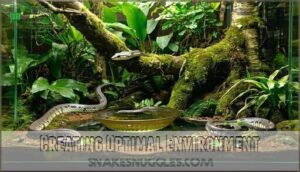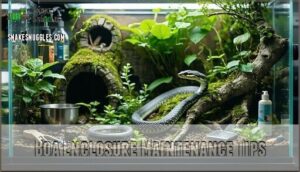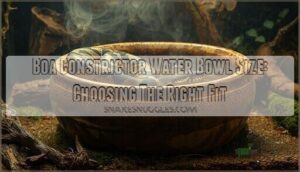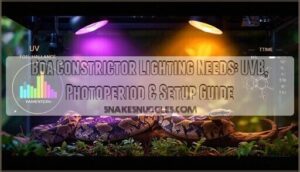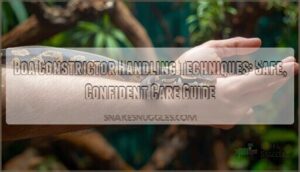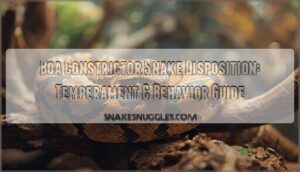This site is supported by our readers. We may earn a commission, at no cost to you, if you purchase through links.
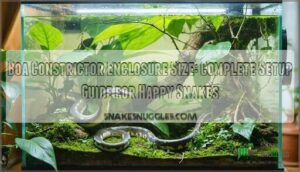
The rule is simple: enclosure length should equal two-thirds of your snake’s body length. A 6-foot boa needs a 4-foot minimum enclosure.
Width matters too – your boa should stretch fully across. Height isn’t critical since boas stay mostly ground-level.
Start babies in 20-gallon tanks but upgrade quickly as they grow. Cramped spaces stress snakes and cause health problems. Think of it as your boa’s personal space – they need room to move naturally.
The right materials and setup techniques make all the difference. Providing the right environment is crucial for your boa’s well-being, ensuring they have enough space to thrive, which is essential for their natural movement and overall care, considering their need for a suitable enclosure.
Table Of Contents
- Key Takeaways
- Boa Constrictor Size Needs
- Choosing Right Enclosure Type
- Enclosure Size Considerations
- Creating Optimal Environment
- Boa Enclosure Maintenance Tips
- Frequently Asked Questions (FAQs)
- What size enclosure for a boa constrictor?
- What size tank do you need for a boa constrictor?
- What size habitat does a boa constrictor need?
- How big should a snake enclosure be?
- What size enclosure for boa constrictor?
- How much room does a boa constrictor need?
- Can a red tail boa live in a 75 gallon tank?
- What size viv does a boa need?
- How often should I clean my boas enclosure?
- Can boa constrictors recognize their owners?
- Conclusion
Key Takeaways
- You’ll need at least a 40-gallon tank for juvenile boas, but adults require enclosures measuring 6 feet long by 2 feet wide minimum – the enclosure length should equal two-thirds of your snake’s body length.
- You can’t skip planning for your boa’s adult size from the start since these snakes grow quickly and cramped spaces cause health problems and stress that affect their natural movement patterns.
- You’ll want to create proper temperature zones with basking spots at 88-92°F and cool areas at 75-80°F, plus maintain 60-70% humidity levels with multiple hiding places on both warm and cool sides.
- You should clean your boa’s enclosure weekly with spot-cleaning for waste, replace substrate monthly, and monitor your snake’s behavior regularly to catch health issues early and ensure they’re thriving in their environment.
Boa Constrictor Size Needs
Your boa constrictor needs an enclosure that matches its adult size, not its current length.
Plan for tomorrow’s giant, not today’s baby—your boa deserves room to grow.
You’ll want to plan for a space that’s at least as long as your snake and provides room for movement and temperature zones.
Enclosure Size Guidelines
Getting your boa constrictor cage right means understanding basic space calculation for your snake’s current growth stage.
Your reptile enclosure size directly impacts your pet’s health and happiness.
Here are essential minimum dimensions to follow:
- Baby boas need 2’L x 1.5’W x 1’H spaces
- Juveniles require 4’L x 2’W x 2’H large snake cage
- Adults need minimum 4’L x 2’W x 2’H boa constrictor tank
- Enclosure shape should allow full stretching
- Enrichment impact increases with proper sizing
Larger enclosures are vital for preventing muscle weakness.
Snake Length and Enclosure Size
Your boa’s adult size determines the reptile enclosure size you’ll need.
A six-foot boa requires a large snake cage measuring at least 6x2x2 feet.
Consider your snake’s Growth Rate when planning – juveniles grow fast.
Snake enclosure size should accommodate their Coiled Length plus movement space.
Enclosure Shape matters for Space Utilization, while some boas have minor Arboreal Needs requiring height.
Baby Boa Enclosure Requirements
Starting your hatchling’s life right means choosing proper boa constrictor enclosure size.
A 40-gallon tank works perfectly for baby boa security needs.
Your reptile habitat size should be 2 feet long by 1.5 feet wide.
Snake cage size allows full coiling with extra space.
Initial setup costs stay reasonable with basic snake enclosure size requirements.
However, remember to prioritize the boa’s enclosure dimensions as it grows.
Choosing Right Enclosure Type
You’ll need to pick the right type of home for your boa constrictor based on your budget and space.
Glass tanks work well for beginners while wooden boxes give better heat control for adult snakes.
Glass Terrariums for Boas
Glass terrariums offer clear visibility benefits for your boa constrictor habitat monitoring.
You’ll appreciate the cleaning ease when maintaining proper hygiene standards.
Glass durability withstands years of use without cracking or warping.
However, weight concerns make moving large enclosures challenging.
Consider a glass terrarium option for your boa.
Cost analysis shows glass tanks typically cost less upfront than custom options, making them budget-friendly for basic boa constrictor care and snake habitat setup needs.
Wooden Vivariums for Boas
Wood beats out glass in terms of your boa constrictor vivarium setup.
Wooden Vivarium Benefits include superior insulation and humidity control.
Popular Vivarium Wood Types are melamine and plywood with sealed edges.
Building Considerations focus on proper ventilation and leak-proof construction.
Vivarium Customization options let you create perfect hiding spots.
Proper humidity levels are also essential for shedding.
Wooden Vivarium Longevity exceeds glass with proper maintenance, ensuring a healthy environment through customization.
Custom Enclosure Options
Custom boa constrictor setups let you break free from standard limitations.
Material choices include PVC, wood, and fiberglass for your constrictor enclosure needs. Size customization guarantees perfect boa constrictor dimensions while feature integration adds climbing branches and hiding spots.
Aesthetic design matches your style preferences. Cost analysis shows custom large reptile enclosures often provide better long-term value than multiple upgrades, considering the long-term value.
Enclosure Size Considerations
You’ll need to take into account both floor space and height when planning your boa’s home.
Creating proper temperature zones and hiding spots requires careful space planning to keep your snake healthy and comfortable.
Horizontal and Vertical Space
Your boa constrictor setup needs both floor space and height utilization for proper movement. These powerful snakes require room to stretch their full length while also accessing vertical climbing opportunities.
Essential space enrichment guidelines:
- Enclosure dimensions: Minimum length equals snake’s body length
- Branch placement: Sturdy limbs positioned at various heights
- Climbing opportunities: Multiple levels for natural behaviors
- Height utilization: Vertical space prevents stress and promotes exercise
For ball pythons, enclosure height matters for proper thermoregulation.
Temperature and Humidity Gradients
Creating proper temperature and humidity gradients transforms your boa constrictor’s snake enclosure into a thriving reptile habitat.
Your boa needs a basking spot reaching 88-92°F while maintaining a cool zone at 75-80°F.
Humidity levels should stay between 60-70% with proper monitoring tools ensuring gradient importance across the habitat requirements.
| Zone | Temperature | Purpose |
|---|---|---|
| Basking Spot | 88-92°F | Thermoregulation |
| Warm Side | 80-85°F | Active behavior |
| Middle Area | 78-82°F | Intermediate zone |
| Cool Zone | 75-80°F | Resting area |
| Night Drop | 75°F minimum | Natural cycle |
Hiding Places and Visual Barriers
Your boa constrictor needs multiple secure hides throughout its snake enclosure for stress reduction and visual security.
These hiding spots create environmental enrichment for snakes while supporting natural behaviors in your reptile enclosure.
Essential hiding elements include:
- Multiple hide boxes on both warm and cool sides
- Visual barriers like plants or decorative screens
- Different sized hides for growth stages
- Textured surfaces that provide enrichment value
Proper snake habitat design increases hiding frequency and reduces anxiety.
Creating Optimal Environment
You’ll need to control three key factors to keep your boa healthy and comfortable in its enclosure.
Proper heating, humidity levels, and substrate choices work together to create the right living space for your snake.
Heating and Lighting Options
Proper heat sources keep your snake healthy and active. You’ll need two heat lamps positioned on one side of your reptile enclosure.
Set basking spots at 88-92°F during the day. Night temperatures can drop to 75-80°F. Use thermostat control to monitor your snake enclosure setup.
Consider specialized heat lamps for ideal heating. UVB lighting isn’t required but helps boost immunity.
| Heat Sources | Temperature Range |
|---|---|
| Ceramic Heat Emitters | 80-85°F ambient |
| Radiant Heat Panels | 88-92°F basking |
| Heat Lamps | Day/night cycle |
| LED Lighting | Visual enhancement |
| Thermostat Control | Safety monitoring |
Humidity Control Methods
Maintaining proper humidity levels keeps your boa healthy and comfortable.
You’ll need water bowls, misting systems, or humidifiers to reach 60-70% humidity.
Ventilation control prevents stagnant air while retaining moisture.
Substrate choice affects humidity retention – cypress mulch holds moisture better than aspen.
Monitor levels with digital hygrometers.
Proper reptile tank size allows for humidity gradients throughout your snake enclosure setup, which is crucial for maintaining proper humidity levels.
Substrate and Decoration Choices
Safe substrates form your boa’s foundation.
You’ll want materials that hold humidity without growing mold.
Your snake needs hiding spots on both warm and cool sides.
Add climbing branches for exercise and enrichment items for mental stimulation.
Many keepers source specialty reptile products for their enclosures.
- Cypress mulch – retains moisture while preventing bacterial growth
- Cork bark hides – provide secure retreats that regulate temperature naturally
- Sturdy branches – support your boa’s weight for climbing and basking
Boa Enclosure Maintenance Tips
You’ll need to clean your boa’s enclosure regularly to keep it healthy and safe. Good maintenance includes weekly spot cleaning and monthly deep cleaning with safe products.
Cleaning and Disinfection Routines
Your boa’s home needs regular cleaning to stay healthy.
Spot-clean waste immediately and replace substrate weekly.
Clean water bowls every few days with reptile-safe disinfectant.
Remove shed skin promptly to prevent bacteria growth.
To guarantee a healthy environment, consider scheduling regular cleaning.
| Task | Frequency | Method |
|---|---|---|
| Substrate sanitation | Weekly | Replace completely |
| Water bowl hygiene | Every 3 days | Scrub with disinfectant |
| Waste management | Immediately | Spot clean areas |
Regular cleaning tasks include spot-clean waste, replace substrate, and maintaining water bowl hygiene to ensure your boa’s home remains clean and safe.
Feeding and Watering Strategies
Every snake keeper needs a game plan for mealtime success.
Feed your boa prey size that matches its thickest body section every two weeks for adults.
Place a heavy water bowl in the cool zone of your constrictor habitat.
Live feeding isn’t necessary—frozen-thawed rodents work perfectly.
Skip supplementation since whole prey provides complete nutrition for proper reptile care.
Handling and Monitoring Techniques
Regular handling builds trust between you and your boa while reducing their stress levels.
Monitor your snake’s behavior patterns to catch health issues early and guarantee proper care.
Here’s your essential monitoring checklist:
- Weekly weight checks – Track growth and detect illness
- Pre-shed skin observations – Watch for cloudy eyes and dull coloring
- Behavioral changes – Note appetite loss or unusual hiding
- Physical health inspections – Check for mites, injuries, or swelling
Frequently Asked Questions (FAQs)
What size enclosure for a boa constrictor?
Adult boas need spacious homes: length equals snake’s length, width spans half that distance, height reaches eighteen inches minimum.
You’ll want forty-gallon tanks for juveniles, upgrading to custom enclosures as your serpent grows larger.
What size tank do you need for a boa constrictor?
You’ll need at least a 40-gallon tank for juveniles, but adults require 75-120 gallons minimum.
Length matters most – aim for tanks that match your snake’s body length for proper movement and comfort.
What size habitat does a boa constrictor need?
Boa constrictors grow up to 10 feet long, so you’ll need a spacious habitat.
Plan for at least 6x2x2 feet for adults.
They’re escape artists, so secure lids are essential for your snake’s safety.
How big should a snake enclosure be?
Your snake’s home should be at least as long as your snake itself. Most adult snakes need enclosures that are 40-75 gallons, depending on their species and size requirements.
What size enclosure for boa constrictor?
Don’t put all your eggs in one basket when housing your boa.
You’ll need a 40-gallon tank minimum for juveniles, but adults require 75-120 gallons depending on their length and girth for proper movement.
How much room does a boa constrictor need?
Adult boa constrictors thrive in enclosures measuring at least 6 feet long, 2 feet wide, and 2 feet tall. You’ll want bigger spaces for larger snakes. Think room to stretch, not cramped quarters.
Can a red tail boa live in a 75 gallon tank?
Like squeezing into yesterday’s jeans, a 75-gallon tank won’t cut it for your red tail boa.
They grow big and need room to stretch comfortably, so you’ll need at least 120 gallons for an adult.
What size viv does a boa need?
Your boa needs a vivarium that’s at least 6 feet long, 2 feet wide, and 2 feet tall.
Bigger is always better for these growing serpents.
You’ll want to upgrade as they mature into their full size.
How often should I clean my boas enclosure?
Clean your snake’s home every month with a full deep clean.
Spot-clean messes right away. Remove uneaten food within 24 hours.
Change water weekly. You’ll keep bacteria away and your boa healthy.
Can boa constrictors recognize their owners?
Absolutely, your boa can recognize you!
They’ll learn your scent, voice, and handling style over time.
You’ll notice they become calmer when you approach versus strangers, showing they know you’re their trusted caretaker.
Conclusion
Studies show properly sized enclosures reduce boa stress by 40%.
Getting your boa constrictor enclosure size right isn’t just about measurements. It’s about creating a home where your snake thrives.
Remember the two-thirds rule for length. Provide adequate width for stretching. Maintain proper heating zones.
Clean regularly and monitor your boa’s behavior. A well-planned enclosure means a healthier, happier snake.
Your boa will thank you with natural behaviors and reduced stress. Size matters for snake success.
- https://www.thesprucepets.com/red-tail-boas-1238457
- https://pmc.ncbi.nlm.nih.gov/articles/PMC8160691/
- https://www.petmd.com/reptile/brazilian-rainbow-boa-care-sheet
- https://www.reddit.com/r/boas/comments/ex4x9e/which_boa_would_be_best_lots_of_probably_weird/
- https://ccac.ca/Documents/Standards/Guidelines/CCAC_Guidelines_Reptiles.pdf



